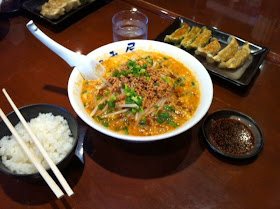Mutsumiya ramen is a popular place it's fair to say. Around lunch you may find yourself waiting if you arrive at peak time. Their different types of ramen have satisfied many bellies on cold and hot days alike.
They are better known as "Red Ramen" to many. Mutsumiya is located right outside the main gate and probably takes second place for the closest restaurant to the base by walking distance. You can find it on the blog map.I put their menu below but some good online photos can be found on their company website (click the second link on the left of the page). They are a chain restaurant and part of a much larger "conglomerate." Despite their being a chain, they boast that they hand make their noodles using only the freshest of ingredients.
You can add some extras to your ramen like nori (dried seaweed), butter, corn, kimchi, etc. for a bit extra. A dish of gyoza will round out the meal and ensure you don't leave hungry.
Mutsumiya is a must when in Yokosuka. There are plenty of other ramen joints in town but Mutsumiya deserves a visit both for its food and its landmark status.
むつみ Mutsumi means harmonious, intimate, close. And of course the "ya" part 屋 occurs frequently enough in restaurant names that if you've been following the blog you should know by now. It means house or shop or roof. Sometimes the kanji will be written as 家 which is pronounced the same and means the same thing. This is also a kanji that has the same meaning in Chinese (and pronounced jia).
Kanji sidebar: 屋 is made up of the two elements: flag (you can see the flag on top with the pole to the left) and climax 至 which further breaks down into 土 which means ground (you could think of it as a telephone pole electrically grounded to the ground) and the four strokes above it which you will learn as wall in Remembering the Kanji (RTK). So the climax 至 kanji I remember from this story - "When the Berlin wall fell to the ground, it was the climax of many peoples lives in Germany."
Now we put flag and climax together. I initially learned this Kanji as roof, but then later learned it also meant house or shop. So for the roof meaning the story went like this "After taking the checkered flag and reaching the climax of his/her racing career, (insert your NASCAR driver name here) stuck his head out the roof of the car and waved to the crowd."
Now we know NASCAR cars don't have sunroofs but it's all about the visual of the story. The more twisted the story is the easier it is to remember the kanji and its associated meaning. If you can give the driver a name, or the flag a "country" even better (for other kanji in which it appears). In my case a checkered flag worked really well.
Once you learn this kanji, then learning "grip" is also easy because 握 this kanji is made up of roof and finger (using RTK keywords). The same image of a racecar driver sticking his head up through the sunroof can be used, with his fingers gripping the opening of the sunroof.
.JPG) |
| That sign means...OPEN |
.JPG) |
| Red Miso Ramen |
.JPG) |
| Milk based white miso ramen |
 |
| A seasonal favorite - tan tan noodles |
#88
.JPG)
.JPG)
.JPG)
.JPG)
.JPG)
.JPG)
Thanks for the kanji lesson. Very helpful and interesting. :)
ReplyDeleteStill open and thriving. Very good ramen.
ReplyDelete